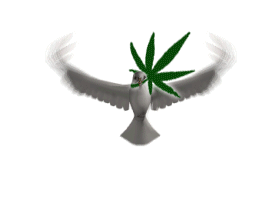Source: http://en.wikipedia.org/wiki/THC_Ministry
The THC Ministry, founded by Roger Christie from the Religion of Jesus Church, is a religion[1] which considers cannabis to be a sacrament. Members base their practices on what they see as an eclectic mixture of ancient wisdom, modern science, and the enlightening and healing properties of cannabis sacrament. Its mission includes “liberating the cannabis hemp plant and the minds of those who do and of those who do not revere it,” and is actively involved in the legal and social discussions surrounding cannabis use in society. On July 8, 2010, Christie and 13 other individuals allegedly associated with the THC Ministry were indicted by a Federal grand jury in Honolulu on Marijuana Possession and Trafficking charges.[2] Christie and seven other defendants remained in custody at the Federal Detention Center, Honolulu, awaiting a September 8, 2010 trial date.[3]
Beliefs
THC Ministry believes that “cultivation and enjoyment of cannabis sacrament is a fundamental human right provided by God and protected by the Constitution.” It states cannabis is the originalsacrament of Hebrew, Christian, Muslim, Hindu, Shinto, Buddhist, Rasta and more, and fulfills the prophesies to ‘feed all our hungers’. It believes cannabis to be one of the main ingredients in the original Anointing Oil, as described in the Bible. Some members also believe it is the substance used in the burnt offerings at the altar and special occasions throughout the bible numerous times.
History
THC Ministry, which is the abbreviated and popularized name for the original Hawai’i Ministry of Cannabis Sacrament and all of its chapters, was founded in June 2000 by Roger Christie in Hawaii. It is present in Australia, Canada, the Netherlands, the United Kingdom and many states of the United States, including Alabama, Arizona, California, Colorado, Florida, Illinois, Indiana, Iowa,Michigan, Missouri, Montana, Nebraska, Ohio, Oregon, Wyoming, Texas, and Tennessee with at least one other chapter forming in New York. It is an officially registered religion in many countries on different continents.
According to the THC Ministry, identification of cannabis specifically as an ingredient of the holy anointing oil, can be found in the Torah (Five Books of Moses), Exodus 30:23; contrary to the translation of the Septuagint and supported by both Aramaic translations (the Targum and the Peshitta).
The Hebrew Bible possibly mentions cannabis in Exodus 30:23 where God commands Moses to make a holy oil of myrrh, cinnamon, qěnēh bośem and cassia to anoint the Ark of the Covenantand the Tabernacle (and thus God’s Temple in Jerusalem).[4] The Biblical Hebrew term qěnēh bośem (קְנֵה בֹּשֶׂם), possibly derived from Sumerian kanubi[citation needed], literally “reed of balm”, probably[5] refers to cannabis according to some etymologists,[6] but is more commonly thought to be lemon grass, calamus, or even sweet cane, due to widespread translation issues.[7]
Notably, the specific anointing oil in question, is a special herbal formula that functions as a kind of polish and fragrance for the Ark and Tabernacle, and the Bible forbids its manufacture and use to anoint people (Exodus 30:31-33) with the exception of the Aaronic priesthood (Exodus 30:30).
In Aryeh Kaplan‘s contemporary English translation of the Five Books, “The Living Torah”, he includes a picture of the hemp plant as an illustration (p. 442).
A judge in Colorado ruled that a man’s belief that marijuana was a sacrament did not rise to the level of religion and ordered him to pay $450 in fines and costs and serve 15 hours of community service as a sentence.[8]
- ^“Hawaii Police Department (HPD) Religious Use Rules”. Thc-ministry.org. Retrieved 2011-04-20.
- ^“New details in the major marijuana bust on the Big Island”.
- ^“The Honolulu StarAdvertiser, July 16, 2010”.
- ^ Rabbi Kaplan. 1981. The Living Torah, pg. 40-41.
- ^Weston La Barre. 1980. Culture in Context; Selected Writings of Weston Labarre. Duke University Press.
- ^ Benetowa, Sara = (Sula Benet). 1936. Tracing one word through different languages. Institute of Anthropological Sciences, Warsaw. Reprinted 1967 In: The Book of Grass. George Andrews and Simon Vinkenoog (eds.) Grove Press, New York, “pp. 15-18.
- ^ Immanuel Löw. 1924-1934. Flora der Juden, vol. I-IV. Reprinted 1967. Hildeshein: Georg Olms (source not confirmed)
- ^“Colo. man who claims pot as sacrament is convicted”.
- THC Ministry Chapters:
- Hawai’i Cannabis Ministry (Original organization founded by Roger Christie)
- THC Ministry Amsterdam (European headquarters and first official THC Ministry founded outside the USA.)
- Green Earth Ministries Alabama (Official THC Ministry founded in Alabama, USA.)
- Other Recognized Churches Supporting THC Ministries
- greenfaith ministry Cannabis Caregiving Church, (Cannabis Sacrament/Medicine Church Recognized by the States of WY, TX, & CO)
- The Entheogenic Reformation Church
- U.L.C. Headquarters (World renowned U.L.C. church and supporter of thc-ministries.)
- Ministry of Cannabis (Cannabis seedbank based in Amsterdam, The Netherlands.)
- Christians for Cannabis (Idaho USA Cannabis Ministry, Christians for Cannabis)



0 Comments